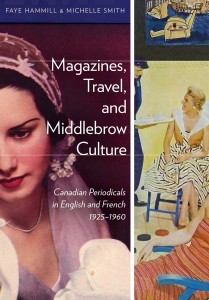In 1955 a round-trip flight from Toronto to Rome was a staggering $677, the modern equivalent of $6,100. It was the cost of a full order of household appliances or a good used car – not that it mattered. Most Canadians went their entire working lives without ever stepping on an airplane for a holiday. Not till 1944 did any province even mandate two weeks’ annual holiday pay for wage earners. A simple vacation was luxury, let alone travel abroad.
“Don’t you get tired of just reading about things?” the frustrated traveler George Bailey is asked in It’s A Wonderful Life. Bailey, like the film audience, accepted he could never get away. So, they dreamed. The phenomenon inspires this compelling book documenting the aspirations of the “middlebrow”, a pejorative first coined in 1924.
Travel “was a symbol of achievement, cultural literacy, savoir faire and personal means,” note authors Faye Hammill and Michelle Smith of the University of Strathclyde in the U.K. To read Magazines, Travel & Middlebrow Culture is to revisit an era when Middle Canada worked a six-day week and fantasized about the fine things in life.
“Magazines, by circulating fantasies of travel, were instrumental in forging a link between geographical mobility and upward mobility,” Middlebrow explains. “They constructed travel as an opportunity to acquire knowledge and prestige as well as to experience pleasure and luxury.”
Authors meticulously researched the contents of six periodicals over a 35-year period that lauded the merits of travel to places that readers would never see. “Money spent in travel is a sound investment,” Maclean’s wrote in 1927. “Nothing can take from you the returns it guarantees – broadmindedness, pleasant education, relaxation, recreation and lasting memories.”
Travel pages, then and now, were advertiser-driven; authors calculate sponsorships by cruise lines, hotels and other tourism operators accounted for 10 percent of advertising over the period; another 40 percent sold automobiles, meaning “the theme of geographical mobility was central to half of the consumer advertising in the magazines.”
The effects were occasionally bizarre.
In August 1935 the monthly Mayfair ran its vacation number with long, overwritten articles extolling Canadian Pacific cruises to Egypt and China: “What a marvelous experience!”, Mayfair enthused; “Would you like a real change? Something that will give you an adventure in comfort, and comfort in adventure.”
Note the month, August ’35, the same period when the Prairie wheat crop was ravaged by frost; industrial unemployment hit 25 percent; and Ontario’s premier announced the province “will be insolvent” if welfare payments kept up. Mayfair readers paid 25¢ — the price of a ten-pound bag of flour – to see how the top one percent sought amusement.
“The magazine declined to engage seriously with the world beyond Canadian high society,” authors note. “Instead, it constructed an artificial realm in which only money, style and social capital counted.” The impact was a “startling lack of perspective”, as witnessed by this July 1935 article headlined En Route: “During a recent European tour, Mr. B.W. Keightley of Montreal included an interesting visit to Germany, where he discussed the situation with many citizens – including a smartly turned-out Nazi Storm Trooper.”
Mayfair halted publication in 1958. Other magazines reviewed by Middlebrow similarly vanished: the Canadian Home Journal in 1958; La Revue Moderne in 1960; La Revue Populaire in 1963. They live on only in this warm and engaging book, when Middle Canada for 25¢ could dream of trips they would never take.
By Holly Doan
Magazines, Travel And Middlebrow Culture: Canadian Periodicals in English and French 1925 to 1960, by Faye Hammill & Michelle Smith; University of Alberta Press; 256 pages; ISBN 9781-7721-120837; $49.95






